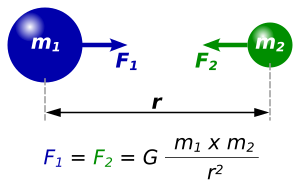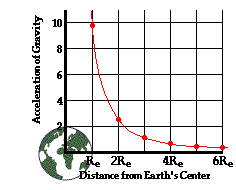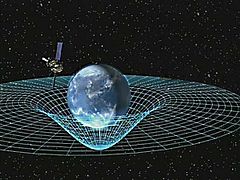Created: 07 May 2022 Published: 07 May 2022 Last updated: 10 May 2022
<To be continued>
If I cannot explain it simply I do not understand it well enough!
But to write it down simply is another challenge.. 😅 Although gravity is used very often to calculate the movement of space craft, an explanation on what it exactly is, is not known today. Thinking on it a few years.. 😆 has resulted in the following theory:

The acceleration of a body due to ’the force of gravity’ is the result of conservation of momentum.
How to explain? Let’s mention first:
- Time (and temperature) are NOT physical properties. They are great measuring and calculation tools but not physical properties.
- As explained on my page on Energy thought experiments the volume that particles and photons reside in is also a form of energy! ( Vacuum energy )
Throwing balls on frictionless ice skates
Let’s first recall the conservation of momentum. When a person with a mass of 100 kg would be standing on frictionless ice-skates and holding 10 balls of 1 kg each and would throw the balls, one after the other, away with a speed of -20 m/s than the reaction of the body would be a response in the opposite direction. Newton’s third law and the conservation of momentum we all grew up with.
First ball 01 to throw:
mtotal ( 110 kg) * 0 (m/s) = 109 (kg) * vme (m/s) + 1 (kg) * -20 (m/s), so vme 01 becomes +0,18 m/s.
- Next ball nr 02 to throw: 109 (kg) * 0,18 (m/s) = 108 * vme 02 + 1 (kg) * -20 (m/s); Vme 02 = 0,37 m/s
- Next ball nr 03 to throw: 108 (kg) * 0,37 (m/s) = 107 * vme 03 + 1 (kg) * -20 (m/s); Vme 03 = 0,56 m/s
- Next ball nr 04 to throw: 107 (kg) * 0,56 (m/s) = 106 * vme 04 + 1 (kg) * -20 (m/s); Vme 04 = 0,76 m/s
- Next ball nr 05 to throw: 106 (kg) * 0,76 (m/s) = 105 * vme 05 + 1 (kg) * -20 (m/s); Vme 05 = 0,95 m/s
- Next ball nr 06 to throw: 105 (kg) * 0,95 (m/s) = 104 * vme 06 + 1 (kg) * -20 (m/s); Vme 06 = 1,15 m/s
- Next ball nr 07 to throw: 104 (kg) * 1,15 (m/s) = 103 * vme 07 + 1 (kg) * -20 (m/s); Vme 07 = 1,36 m/s
- Next ball nr 08 to throw: 103 (kg) * 1,36 (m/s) = 102 * vme 08 + 1 (kg) * -20 (m/s); Vme 08 = 1,57 m/s
- Next ball nr 09 to throw: 102 (kg) * 1,57 (m/s) = 101 * vme 09 + 1 (kg) * -20 (m/s); Vme 09 = 1,78 m/s
- Next ball nr 10 to throw: 101 (kg) * 1,78 (m/s) = 100 * vme 10 + 1 (kg) * -20 (m/s); Vme 10 = 2,00 m/s
So after throwing 10 balls this person has accelerated to a speed of 2,00 m/s without any external force acting upon his body. The total acceleration has been 2,00 m / (s * ’time of 10 throws’).
The point to make here: is that a series of events regarding internal system conservation of momentum also may lead to the observation by an external observer of an external force being at work.
<To be continued>
The apparent acceleration due to the apparent force of gravity is the -reaction of a body to the action imposed by the earth’s gravity field.
When a body would be placed just within the edge of the earth’s gravitational field it’s acceleration would be:
abody = G * Mearth / r2
where
- a is acceleration
- Mearth is the mass of the earth
- r is the distance to the earth
- G is the Gravitational constant.
But what imposed action = – reaction the resulting acceleration is a response to?
Matter is emptiness
For the sake of this thought experiment let’s first talk about a body is made of iron. (It can be any material because all mass responds the same to gravity.)
One atom of iron contains 26 protons, 30 neutrons and 26 electrons as building blocks. When dividing the standard atomic weight of 55,845 gram per mole by the Avogrado number we get 9,273 * 10-23 grams per atom.
Subtracting the weight of the 82 particles leaves 1,03*10-24 grams unaccounted for. When we see matter not only made out of particles with mass but as ‘inertia from (particles + photons + volume)’ it would make sense the unaccounted inertia is due to the energy in the photons and volumes in between the particles.
Now 1 atom of iron has a radius of 126 pm or 126 * 10-12. What part of the atomic volume do all particles take up? The proton has a charge radius of 8,8*10-16 m, the neutron of 8*10-16m and the electron 1*10-22m.
One mole of iron inhabits a volume of 7,09 * 10-6 m3. Assuming the atomic particles are spheres and close packing them gives a minimal volume of 1,48 * 10-19 m3 that is needed to contain all particles. So only a fraction of 2,09 * 10-14 is filled with particles.
So at least 1 – 2,09 * 10-14 = 99,99999999999790 % is ‘volume’ (at the earth surface and when temperature above 0 K 😄)
The point to make here: is that matter that for us looks and feels solid in reality is mostly emptiness. The particles are merely a small pollution in the volume. Just as our solar system is travelling through empty space but in itself is also mostly empty space. there is enough ‘empty volume’ to evict energy that could result in the acceleration of the body of iron.
Space-time representation is just energy density of volume
Space-time is a strange word since time is not a physical property. But imagining the volume as a material with the name ‘energy’, with properties like density etc , see the Wiki page on Vacuum energy, would make space-time a lot clearer. Just compare this picture with the already shown ‘acceleration of gravity’ plot.

Exactly the same..
So when the volume energy density near large masses is lower than far away from large masses than the energy must be evicted on the travel towards a large mass.
What would this mean?
- A long rod would be longer in space than on earth
- The total inertia(mass) of matter would be greater than on earth.
How much energy would have to be evicted to get the acceleration?


